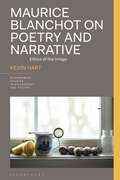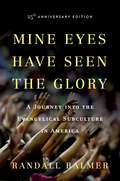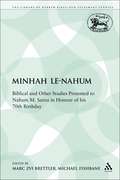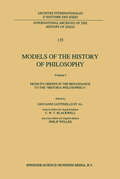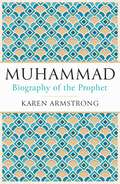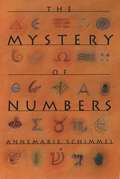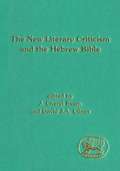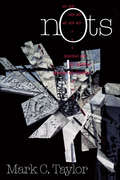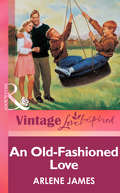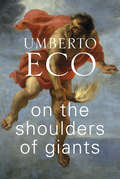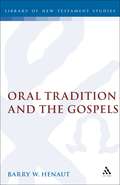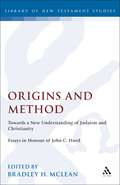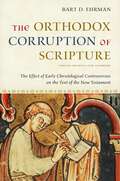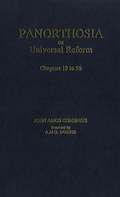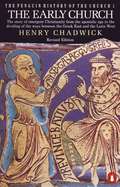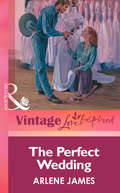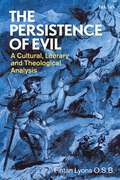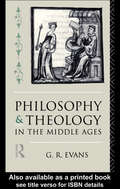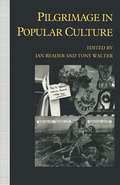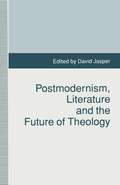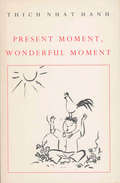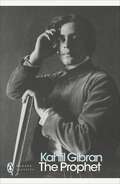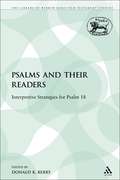- Table View
- List View
Maurice Blanchot on Poetry and Narrative: Ethics of the Image (Bloomsbury Studies in Philosophy and Poetry)
by Kevin HartBlanchot and his writings on three major poets, Mallarmé, Hölderlin, and Char, provide a decisive new point of departure for English language criticism of his philosophical writings on narrative in this study by leading Blanchot scholar, Kevin Hart.Connecting his work to later leading figures of 20th-century French philosophy, including Emmanuel Levinas, Simone Weil, and Jacques Derrida, Hart highlights the importance of Jewish philosophy and political thought to his overall conception of literature. Chapters on community and negation reveal Blanchot's emphasis on the relationship between narrative and politics over the more commonly connected narrative and aesthetics. By fully discussing Blanchot's elusive concept of “the Outside” for the first time, this book progresses scholarly understandings of his entire oeuvre further. This central concept engages Franz Rosenzweig's work on Abrahamic faiths, enabling a reckoning on the role of suffering and literature in the wake of the Shoah, with significant implications for Jewish studies more generally.
Mine Eyes Have Seen the Glory: A Journey Into The Evangelical Subculture In America
by Randall BalmerMinhah Le-Nahum: Biblical and Other Studies Presented to Nahum M. Sarna in Honour of his 70th Birthday (The Library of Hebrew Bible/Old Testament Studies)
by Marc Zvi Brettler Michael FishbaneNahum Sarna's distinctive and original scholarship has taken in a wide range of subject areas from work on Genesis and the Psalms to his Jewish Bible commentary and the English translation of the Ketuvim. At first Assistant Professor of Bible at the Jewish Theological Seminary of America in the 1950s, he was Dora Golding Professor of Bible at Brandeis University from 1965 to his retirement. This collection of 22 essays reflects Professor Sarna's breadth of interests, with contributions from the late Gershon Cohen on the Hebrew Crusade Chronicle and the Ashkenazic tradition; Judah Goldin on Reuben; Moshe Greenberg and Jonas Greenfield on the work of the Jewish Publication Society's Ketuvim translators; and Shemaryahu Talmon on fragments of a Psalms scroll from Masada.
Models of the History of Philosophy: From its Origins in the Renaissance to the ‘Historia Philosophica’ (International Archives of the History of Ideas Archives internationales d'histoire des idées #135)
by C. W. Blackwell Philip WellerModels of the History of Philosophy. From its Origins in the Renaissance to the `Historia philosophica' (a translation of a work published in 1981 in Italian - the bibliography has been updated) gives a comprehensive description of the various forms and approaches in the literature of the history of philosophy from the fifteenth to the middle of the seventeenth century. Several traditions are described, from the well known `prisca theologia' and `perennis philosophia' traditions of Marsilio Ficino and Augustino Steuco, which claimed that the Greeks got their philosophy from the East, to the unknown influence of Scepticism on the history of philosophy by the recovery of Sextus Empiricus, and the German Protestant critical attack on Greek philosophy as Atheistic which was the tradition of the history of philosophy out of which Leibniz developed. Each individual historian of philosophy is given a separate entry which includes a biography, a complete bibliography of his works, a description of his history of philosophy and ends with both an assessment of his reputation during his own time and a complete listing of recent literature on him. As a result the substantial variety in the way the history of philosophy was written and, with it, an overview of the way western civilization developed is described in detail for the first time. For university history of literature, history of culture, history of religion and history of philosophy classes. The book can be used both for undergraduate courses (for specific reading assignments) and as background material for graduate courses. The bibliography provides important aids to many topics which have previously been almost inaccessible.
Muhammad: Biography of the Prophet
by Karen ArmstrongA life of the prophet Muhammad by bestselling author Karen Armstrong.'Armstrong has a dazzling ability: she can take a long and complex subject and reduce it to its fundamentals, without over-simplifying' SUNDAY TIMES'One of our best living writers on religion' FINANCIAL TIMES'Not just a sympathetic book that would dispel the misconceptions and misgivings of its western readers, but also a book that is of considerable importance to Muslims' MUSLIM NEWSMost people in the West know very little about the prophet Muhammad. The acclaimed religious writer Karen Armstrong has written a biography which will give us a more accurate and profound understanding of Islam and the people who adhere to it so strongly. Muhammad also offers challenging comparisons with the two religions most closely related to it - Judaism and Christianity.
The Mystery of Numbers
by Annemarie SchimmelWhy is the number seven lucky--even holy--in almost every culture? Why do we speak of the four corners of the earth? Why do cats have nine lives (except in Iran, where they have seven)? From literature to folklore to private superstitions, numbers play a conspicuous role in our daily lives. But in this fascinating book, Annemarie Schimmel shows that numbers have been filled with mystery and meaning since the earliest times, and across every society. In The Mystery of Numbers Annemarie Schimmel conducts an illuminating tour of the mysteries attributed to numbers over the centuries. She begins with an informative and often surprising introduction to the origins of number systems: pre-Roman Europeans, for example, may have had one based on twenty, not ten (as suggested by the English word "score" and the French word for 80, quatrevingt --four times twenty), while the Mayans had a system more sophisticated than our own. Schimmel also reveals how our fascination with numbers has led to a rich cross-fertilization of mathematical knowledge: "Arabic" numerals, for instance, were picked up by Europe from the Arabs, who had earlier adopted them from Indian sources ("Algorithm" and "algebra" are corruptions of the Arabic author and title names of a mathematical text prized in medieval Europe). But the heart of the book is an engrossing guide to the symbolism of numbers. Number symbolism, she shows, has deep roots in Western culture, from the philosophy of the Pythagoreans and Platonists, to the religious mysticism of the Cabala and the Islamic Brethren of Purity, to Kepler's belief that the laws of planetary motion should be mathematically elegant, to the unlucky thirteen. After exploring the sources of number symbolism, Schimmel examines individual numbers ranging from one to ten thousand, discussing the meanings they have had for Judaic, Christian, and Islamic traditions, with examples from Indian, Chinese, and Native American cultures as well. Two, for instance, has widely been seen as a number of contradiction and polarity, a number of discord and antithesis. And six, according to ancient and neo-platonic thinking, is the most perfect number because it is both the sum and the product of its parts (1+2+3=6 and 1x2x3=6). Using examples ranging from the Bible to the Mayans to Shakespeare, she shows how numbers have been considered feminine and masculine, holy and evil, lucky and unlucky. A highly respected scholar of Islamic culture, Annemarie Schimmel draws on her vast knowledge to paint a rich, cross-cultural portrait of the many meanings of numbers. Engaging and accessible, her account uncovers the roots of a phenomenon we all feel every Friday the thirteenth.
The New Literary Criticism and the Hebrew Bible (The Library of Hebrew Bible/Old Testament Studies)
by J. Cheryl Exum David J. ClinesThe purpose of this original volume is to illustrate what has been happening recently in Hebrew Bible studies under the influence of developments in literary theory in the last couple of decades. The methods and practice of reader-response criticism and deconstruction, as well as of feminist, materialist and psychoanalytic approaches are represented here by essays from leading Hebrew Bible literary critics. Alice Bach, Robert Carroll, Francisco Garcia-Treto, David Jobling, Francis Landy, Stuart Lasine, Peter Miscall, Hugh Pyper, Robert Polzin, and Ilona Rashkow, together with the two editors, present distinctive and eclectic essays on particular biblical texts, introducing students and scholars to exciting new dimensions of biblical study.
Nots (Religion and Postmodernism)
by Mark C. TaylorNots is a virtuoso exploration of negation and negativity in theology, philosophy, art, architecture, postmodern culture, and medicine. In nine essays that range from nihility in Buddhism to the embodiment of negativity in disease, Mark C. Taylor looks at the surprising ways in which contrasting concepts of negativity intersect. In the first section of this book, Taylor discusses the question of the "not" in the religious thought of Anselm, Hegel, Derrida, and Nishitani. In the second part, he analyzes artistic efforts "to figure not" in the work of artists Arakawa and Madeline Gins, architect Daniel Libeskind, pop artist David Sallee, and pop icon Madonna. The final section consists of a deeply personal and scientifically informed chapter that discusses the workings of negativity in immunology and illness. Taylor's essays work toward a sense of the not as unnameable as it is irrepressible—an "unthinkable third" that falls between being and nonbeing. Bringing together concerns that span Taylor's early investigations of Hegel and Kierkegaard and recent studies of art and architecture, Nots is an important contribution by one of the most original and distinctive voices now writing on the American scene. Religion and Postmodernism series
An Old-Fashioned Love (Mills And Boon Vintage Love Inspired Ser. #2)
by Arlene JamesEVERYDAY MIRACLES TRIPLE TROUBLE!
On the Shoulders of Giants: The Milan Lectures
by Umberto EcoThe final collection of essays from the internationally acclaimed and bestselling author of The Name of the Rose and The Prague Cemetery, on the subjects of art and culture.In this collection of essays we find Umberto Eco’s perennial areas of interest explored in a lively and engaging style, accompanied by beautiful reproductions of the art he discusses. In these wide-ranging pieces he explores the roots of our civilization, changing ideas of beauty, our obsession with conspiracies and the emblematic heroes of the great narrative, amongst other fascinating topics.Umberto Eco was one of the most influential, and entertaining, intellectuals of the last century, as well as being a critically acclaimed and bestselling writer of both fiction and non-fiction.
Oral Tradition and the Gospels: The Problem of Mark 4 (The Library of New Testament Studies #82)
by Barry HenautThe problem of oral tradition is well known, for without some theory of this medium no history of Jesus would be possible. This study examines Mark 4.1-34 in the light of three distinctive models of orality: Rudolf Bultmann's form-critical method, B. Gerhardsson's 'Memory and Manuscript' theory and the recent contribution of W. Kelber. The form-critically separate units in the test (allegory, parables and aphorisms) are examined on the basis of their attestation in various documents (Mark, Q, Thomas) to determine whether independent versions of these sayings can be identified and what they tell us about the oral phase and Jesus. This analysis suggests that the criteria for authenticity of 'distinctiveness' and 'multiple attestation' need to be re-examined in light of the folkloric understanding of orality.
Origins and Method--Towards a New Understanding of Judaism and Christianity: Essays in Honour of John C. Hurd (The Library of New Testament Studies)
by Bradley H. McLeanThis collection of essays is presented in honour of John C. Hurd on the occasion of his retirement as Professor of New Testament at Trinity College, Toronto, and in recognition of a distinguished career in the fields of Pauline studies and computing in the humanities. Given Professor Hurd's interest in Christian origins and methodology, it is appropriate that the contributors to this volume deal with the origin and development of various aspects of Judaism and Christianity. In particular they highlight how a greater attentiveness to method has resulted in a reshaping of our understanding of Christianity or Judaism. The volume is divided into three parts: 'New Understandings of Paul', 'New Understandings of the New Testament', and 'New Understandings of the Relationship between Judaism and Christianity'. Contributors include Walter Aufrecht, Karl Donfried, Robert Grant, John Kloppenborg, Gerd Ludemann and Wayne McCready.
The Orthodox Corruption of Scripture: The Effect of Early Christological Controversies on the Text of the New Testament
by Bart D. EhrmanVictors not only write history: they also reproduce the texts. Bart Ehrman explores the close relationship between the social history of early Christianity and the textual tradition of the emerging New Testament, examining how early struggles between Christian "heresy" and "orthodoxy" affected the transmission of the documents over which many of the debates were waged. He makes a crucial contribution to our understanding of the social and intellectual history of early Christianity and raises intriguing questions about the relationship of readers to their texts, especially in an age when scribes could transform the documents they reproduced. This edition includes a new afterword surveying research in biblical interpretation over the past twenty years.
Panorthosia by Comenius 19-26
by A.M.O. DobbiePanorthosia (Universal Reform) is the essential theme of John Amos Comenius's famous Consultation on the Reform of Human Affairs, and chapters 19-26 represent its climax. In this volume is presented the first English translation of this major work of Comenius, which was lost from about 1672 until 1934 when the Latin scholars of Czechoslovakia had it edited for publication in Prague in 1960.
The Penguin History of the Church: The Early Church (Penguin History Of The Church Ser. #Vol. 1)
by Henry ChadwickExamines the beginning of the Christian movement during the first centuries AD, and the explosive force of its expansion throughout the Roman world
The Perfect Wedding (Mills And Boon Vintage Love Inspired Ser.)
by Arlene JamesEVERYDAY MIRACLES A BRIDE AT LAST?
The Persistence of Evil: A Cultural, Literary and Theological Analysis
by Revd Fintan Lyons O.S.B.Recording the history of the belief in the existence of Satan, this book draws from the Bible, the poetry of Dante and Milton, the legend of Faust, and from modern novels and plays such as the works of Mark Twain and G.B. Shaw, and the spiritual writing of C. S. Lewis. Fintan Lyons O.S.B. chronicles the decline of that belief through the centuries as well as the attempts to treat the problem of evil philosophically, using the insights of thinkers such as Karl Barth. At the heart of this book is the attempt to synthesise or reconcile traditional belief with contemporary concern or even alarm regarding evil in the world. Lyons argues that evidence for the persistence of evil has been striking in modern times in wars and atrocities, while phenomena such as Satanic Cults and possible or real diabolical possession have continued to increase. The Catholic Church reacted to this situation in 1998 with a revision of the 1614 Rite of Exorcism, analysed in this book from both theological and psychological standpoints. By arguing that the transition from belief in Satan to personification of evil in historical regimes and characters brings contemporary culture into sharp focus, this book chronicles the history of humanity's attempt to understand the disturbing and mysterious reality of evil.
Philosophy and Theology in the Middle Ages
by G. R. EvansIn the ancient world being a philosopher was a practical alternative to being a christian. Philosophical systems offered intellectual, practical and moral codes for living. By the Middle Ages however philosophy was largely, though inconsistently, incorporated into Christian belef. From the end of the Roman Empire to the Reformation and Renaissance of the sixteenth century Christian theologians had a virtual monopoly on higher education. The complex interaction between theology and philosophy, which was the result of the efforts of Christian leaders and thinkers to assimilate the most sophisticated ideas of science and secular learning into their own system of thought, is the subject of this book. Augustine, as the most widely read author in the Middle Ages, is the starting point. Dr Evans then discusses the classical sources in general which the medieval scholar would have had access to when he wanted to study philosophy and its theological implications. Part I ends with an analysis of the problems of logic, language and rhetoric. In Part II the sequence of topics - God, cosmos, man follow the outline of the summa, or systematic encyclopedia of theology, which developed from the twelfth century as a text book framework. Does God exist? What is he like? What are human beings? Is there a purpose to their lives? These are the great questions of philosophy and religion and the issues to which the medieval theologian addressed himself. From `divine simplicity' to ethics and politics, this book is a lively introduction to the debates and ideas of the Middle Ages.
Philosophy and Theology in the Middle Ages
by G. R. EvansIn the ancient world being a philosopher was a practical alternative to being a christian. Philosophical systems offered intellectual, practical and moral codes for living. By the Middle Ages however philosophy was largely, though inconsistently, incorporated into Christian belef. From the end of the Roman Empire to the Reformation and Renaissance of the sixteenth century Christian theologians had a virtual monopoly on higher education. The complex interaction between theology and philosophy, which was the result of the efforts of Christian leaders and thinkers to assimilate the most sophisticated ideas of science and secular learning into their own system of thought, is the subject of this book. Augustine, as the most widely read author in the Middle Ages, is the starting point. Dr Evans then discusses the classical sources in general which the medieval scholar would have had access to when he wanted to study philosophy and its theological implications. Part I ends with an analysis of the problems of logic, language and rhetoric. In Part II the sequence of topics - God, cosmos, man follow the outline of the summa, or systematic encyclopedia of theology, which developed from the twelfth century as a text book framework. Does God exist? What is he like? What are human beings? Is there a purpose to their lives? These are the great questions of philosophy and religion and the issues to which the medieval theologian addressed himself. From `divine simplicity' to ethics and politics, this book is a lively introduction to the debates and ideas of the Middle Ages.
Pilgrimage in Popular Culture
by Ian Reader Tony WalterSpecially commissioned studies of popular pilgrimages - East and West, past and present, religious and 'secular - ranging from Shikoku (Japan), to Santiago de Compostela (Spain), Kosovo (Yugoslavia), Glastonbury, Anfield (UK), Flanders fields, Graceland and military pilgrimages in the USA. The book asks in what ways all these can be called pilgrimages and what their relation is to tourism and to entertainment, highlighting the enduring popularity not only of pilgrimage but also of saints and heroes.
Postmodernism, Literature and the Future of Theology (Studies in Literature and Religion)
by D. JasperThese essays are written by scholars from widely differing disciplines and traditions. Theologians, philosophers, literary critics and historians of ideas approach the question of how the judaeo-Christian tradition of theological reflection has suffered from and will negotiate the emergence of postmodern theory and practice in literature and criticism. Chapters deal with specific texts from Euripides to contemporary fiction, and with the traditions of cultural theory from Nietszche to Benjamin, to Derrida and what David Klemm identifies as the tragedy of present theology.
Present Moment, Wonderful Moment: Mindfulness Verses For Daily Living (Buddhism Ser.)
by Thich Nhat HanhPresent Moment, Wonderful Moment contains a wide range of short, evocative verses which we can use as meditations as we go about our daily affairs. Each verse is accompanied by a commentary, and the themes that are explored include: smiling at you anger; opening the window; getting dressed; serving food; greeting someone; washing vegetables; watering the garden and driving the car. Thich Nhat Hanh provides a perfect aid to mediation whatever you are during the day.
The Prophet: Penguin Classics (Penguin Modern Classics)
by Robin Waterfield Khalil GibranFirst published in the 1920's, THE PROPHET an inspirational, allegorical guide to living, the book is perhaps the most famous work of religious fiction of the Twentieth Century and has sold millions of copies in more than twenty languages. Gibran'sprotagonist, called simply 'the Prophet', delivers spiritual, yet practical, homilies on a wide variety of topics central to daily life: love, marriage and children; work and play; possessions, beauty, truth, joy and sorrow, death and many many more.
The Psalms and their Readers: Interpretive Strategies for Psalm 18 (The Library of Hebrew Bible/Old Testament Studies)
by Donald K. BerryA reader-oriented approach provides a substantially new angle of vision on Psalm 18 and Psalms study in general. Reader-based interpretation is compared to conventional methodologies by means of four separate analyses of Psalm 18: a textual study, a form-critical explication, a rhetorical study, and an experimental reader-oriented study involving the following strategies. Initially, the components of the text are considered as networks of signals for the reader. Secondly, the text's speech acts are isolated and typified. Thirdly, the ancient and contemporary contexts for the reading of the psalm are examined. The reader-oriented study culminates in two perspectives upon Psalm 18. The psalm may be read as a ritual speech act performed by the community of ancient worshippers, or as a lyric poem that each contemporary reader experiences by identification with the speaker. The concluding chapter reviews each of the methodologies, evaluating strengths and weaknesses, as well as interrelationships among methods.
Rabbis and Jewish Communities in Renaissance Italy (The Littman Library of Jewish Civilization)
by Robert BonfilFocusing on the figure of the rabbi, this book provides a vivid picture of Italian Jewry during the Renaissance. The author discusses Jewish life of the period (c.1450–1600) in its social, institutional, and cultural aspects, placing them against the backdrop of the wider Catholic environment to give an original interpretation of how Jewish cultural and religious life developed in the Renaissance context. Particular attention is given to changes in the status and functions of the rabbis and to the relations between the rabbinate and the lay leadership. Of special interest is the exploration of the cultural world of the rabbis and the broader issue of intellectual developments at the time. Essentially a translation of Part I of the Hebrew edition, which won wide acclaim for its perspective, Rabbis and Jewish Communities in Renaissance Italy has been carefully adapted for an English-speaking readership. Substantial excerpts from the appendices have been incorporated into the text so that the evidence necessary to support the arguments is easily accessible.
